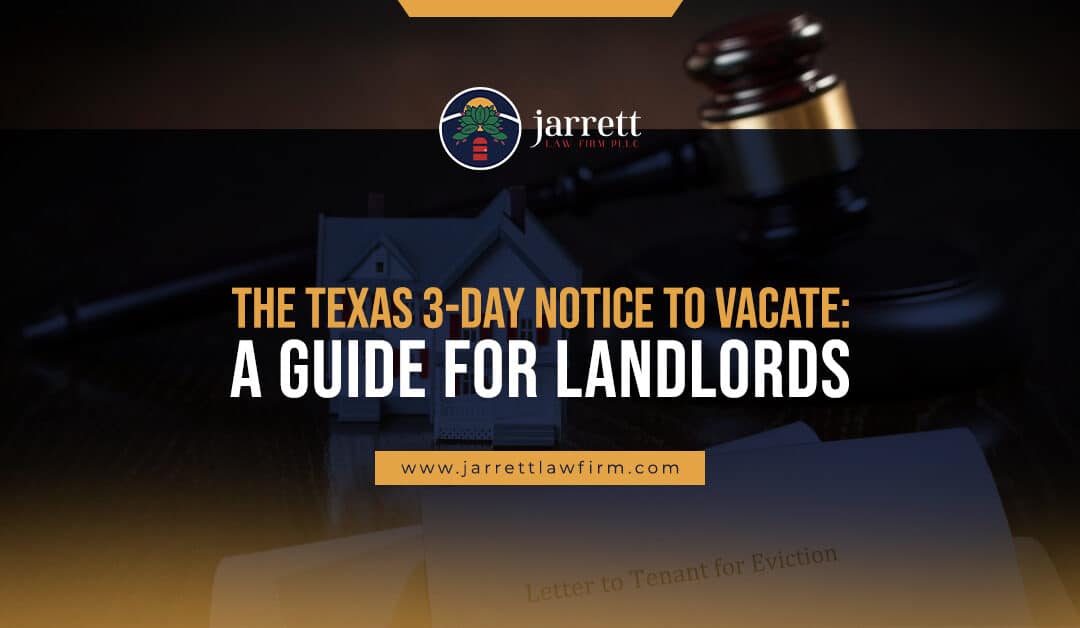Being a landlord in Texas means navigating a sea of statutes, where each clause and subsection can significantly impact your rights and duties. Among these, the Texas Property Code guides residential tenancies. However, one aspect of this statute is familiar to most landlords: the Texas 3-Day Notice to Vacate.
This isn’t just a piece of paper; it’s your first step in reclaiming your property when things go really wrong. Whether you’re a seasoned real estate investor or just starting out with your first rental property, understanding this notice is crucial.
So read on as we clarify the legal jargon, making it accessible and manageable. We’ll ensure you’re well-equipped to handle this part of your landlord journey with confidence and ease.
Understanding the Texas 3-Day Notice to Vacate
When you find yourself needing to start the eviction process, the Texas 3-Day Notice to Vacate isn’t just the first step; it’s a critical move in safeguarding your rental property.
Let’s break it down, making sure you grasp every crucial element.
Definition and Purpose
At its core, the Texas 3-Day Notice to Vacate serves as a clear warning to your tenant: rectify the lease violation, usually by paying the past due rent, within three days, or face an eviction suit.
It’s a legal document that kick-starts the eviction process under Texas law, but it’s also a final olive branch, giving the tenant a brief window to address their misstep.
Legal Requirements for Issuing the Notice
Texas state law mandates that landlords provide this notice before filing an eviction lawsuit. Crafting and Delivering the Notice
Drafting the Notice
The Texas 3-Day Notice to Vacate must clearly state that the tenant has three days to vacate the rental property due to a specific violation of the lease agreement.
Accuracy and clarity here are non-negotiable. You’ll need to detail the lease violation and mention the potential for an eviction suit if the notice period lapses without remediation of the lease breach or if the tenant fails to vacate.
Delivery Methods
Texas law allows for the notice to be delivered in person to the tenant or anyone aged 16 or above at the premises via regular mail, certified mail with a return receipt requested, or by simply posting it on the inside of the rental unit’s main entrance door.
However, choosing certified mail or hand delivery offers proof of receipt, which can be invaluable if you end up in court.
Crafting the Notice: Dos and Don’ts
When you draft this eviction notice, clarity and completeness are your best friends.
Here’s what you absolutely need to include:
- A clear command to vacate within three days due to lease violations, like unpaid rent.
- The specific lease terms that have been violated.
- A statement that legal action (an eviction suit in the Texas Justice or Peace Court) will follow if the tenant fails to comply.
Avoid vague language or any implication that the tenant could rectify the situation by paying the overdue amount after the three-day period unless you’re genuinely open to accepting late rent.
Delivering the Notice: A Step-by-Step Guide
- Choose Your Delivery Method: Decide between hand delivery, certified mail with return receipt, or regular mail. Remember, proof of delivery can be crucial.
- Document Everything: Keep a copy of the notice and any delivery receipts. If you post the notice on the door, take a photo as evidence.
- Observe the Three-Day Period: The countdown starts the day after delivery. If the final date falls on a weekend or holiday, extend the deadline to the next business day.
What Happens Next?
If the tenant obeys the notice and vacates, you can breathe a sigh of relief and prepare the rental unit for the next occupant.
But if the tenant stays put, you can file an eviction suit in your local Justice Court, marking the start of formal eviction proceedings.
Understanding the Texas 3-Day Notice to Vacate is pivotal in managing your rental property effectively. It’s about upholding your rights while providing a fair warning to the tenant.
Keep your approach professional and informed, ensuring you adhere to Texas law every step of the way. Working with an eviction attorney can help ensure you dot every i and cross every t as you go through the process.
When to Issue the Texas 3-Day Notice to Vacate
First off, it’s crucial to recognize that issuing a Texas 3-Day Notice to Vacate isn’t a step to take lightly. This notice comes into play when a tenant has breached the lease agreement in a manner that warrants eviction under Texas law, most commonly for non-payment of rent.
Before dropping this notice in your tenant’s mailbox or attaching it to their door, ensure you’ve got a solid grasp of the lease violations that justify such a step.
Lease Violations and Landlord’s Recourse
If your tenant has fallen behind on rent, before reaching for the eviction notice, review your rental agreement.
- Have you communicated with your tenant about the overdue rent?
- Does it specify a grace period?
Remember, this notice is a precursor to legal action, so it’s paramount to ensure all ducks are in a row.
After the Notice Period
If the Tenant Complies or Vacates
Should the tenant remedy the lease violation within the three-day notice period or vacate the property, the potential crisis is averted.
It’s crucial, however, to inspect the property for damage and ensure the return of keys aligns with your lease agreement’s stipulations regarding the security deposit and property condition upon vacating.
Moving Forward with an Eviction Suit
If the tenant neither rectifies the breach nor vacates the property within the given timeframe, your next step is to file an eviction suit in the appropriate Texas justice court.
This legal action, known as a forcible entry and detainer suit, requires preparation and understanding of the court procedures, potentially necessitating the guidance of a licensed attorney to navigate successfully.
Engaging with the Legal Process
The eviction suit initiates a legal process that includes an eviction hearing, where both you and the tenant will have the opportunity to present your sides of the story.
Familiarize yourself with the requirements for filing the suit, including any court fees and necessary documentation, to avoid any procedural missteps that could delay your case.
In navigating the eviction landscape within Texas, understanding the nuances of the Texas 3-Day Notice to Vacate is a cornerstone for landlords. This knowledge not only equips you to protect your property and investment but also underscores the importance of clear communication, thorough documentation, and, when necessary, decisive legal action.
We Can Help
At Jarrett Law, we understand the challenges and complexities you face as a Texas landlord. Navigating the eviction process, especially drafting and serving the Texas 3-Day Notice to Vacate, can feel overwhelming.
But you’re not alone in this journey. Our team’s focus is on Texas rental agreements and eviction proceedings, ensuring you have the support and guidance needed to protect your property and interests.
Personalized Legal Solutions
Every rental unit, lease agreement, and tenant situation is unique. That’s why we offer personalized consultations to understand your specific circumstances.
Whether it’s a matter of unpaid rent, a lease violation, or another issue that necessitates legal action, we tailor our approach to meet your needs.
Expertise in Texas Eviction Law
With years of experience in Texas eviction law, we have an in-depth understanding of the legal process, from serving the correct eviction notices to representing property owners in Texas Justice Court.
We’re here to ensure that when you need to pursue legal action, every step you take is informed, compliant, and strategic.
Comprehensive Support Through the Eviction Process
Filing an eviction suit, navigating the justice court system, and understanding the nuances of obtaining a writ of possession are tasks that require meticulous attention to detail.
Our team stands by you throughout the entire process, providing clear explanations and practical advice.
We’ll help you understand your landlord options, including how to properly serve a written notice to vacate, file an eviction, and enforce a forcible entry and detainer.
Staying Ahead of the Laws
Texas laws frequently change, and staying abreast of these updates is crucial for landlords.
Jarrett Law ensures you’re always informed about the latest in eviction procedures, federal programs affecting evictions, and any grace periods or specific requirements that could impact your eviction notice or lawsuit.
Why Choose Jarrett Law?
Choosing Jarrett Law means partnering with a team that not only understands the Texas eviction landscape but also values your peace of mind. We prioritize clear communication, so you’ll never find yourself wondering about the next step or your position.
From drafting the initial eviction notice to standing by your side in court, we’re here to navigate the legalities, so you can focus on managing your rental property’s success.
Remember, serving a Texas 3-Day Notice to Vacate is often just the beginning of the eviction process.
Let Jarrett Law help you ensure that every action you take is legally sound, efficient, and aimed at achieving the best possible outcome for your situation. Together, we can protect your investment and maintain the integrity of your rental business.

